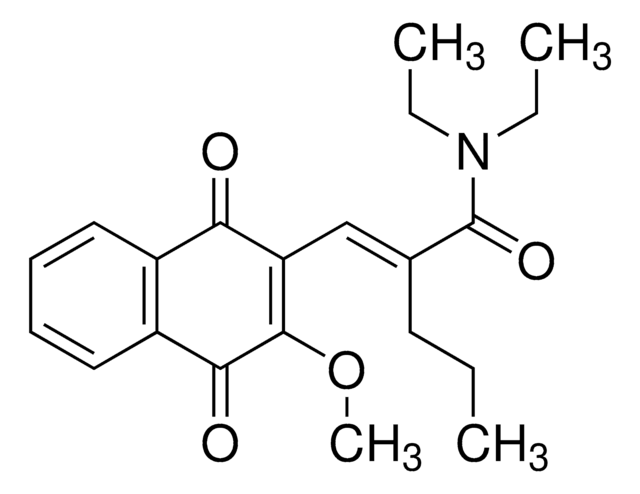262017
APE1 Inhibitor III
The APE1 Inhibitor III controls the biological activity of APE1. This small molecule/inhibitor is primarily used for Cell Structure applications.
Synonyme(s) :
APE1 Inhibitor III, Apurinic Endonuclease 1 Inhibitor III, Apurinic/Apyrimidinic Endonuclease 1 Inhibitor III, N-(3-(1,3-Benzo[d]thiazol-2-yl)-6-isopropyl-4,5,6,7-tetrahydrothieno[2,3-c]pyridin-2-yl)acetamide, N-(3-(1,3-Benzo[d]thiazol-2-yl)-6-isopropyl-4,5,6,7-tetrahydrothieno[2,3-c]pyridin-2-yl)acetamide, Apurinic Endonuclease 1 Inhibitor III, Apurinic/Apyrimidinic Endonuclease 1 Inhibitor III
About This Item
Produits recommandés
Niveau de qualité
Pureté
≥95% (HPLC)
Forme
solid
Fabricant/nom de marque
Calbiochem®
Conditions de stockage
OK to freeze
protect from light
Couleur
brown
Solubilité
DMSO: 2.5 mg/mL
Conditions d'expédition
ambient
Température de stockage
2-8°C
Chaîne SMILES
CC(C)N(CC1)CC2=C1C(C3=NC4=C(C=CC=C4)S3)=C(S2)NC(C)=O
Description générale
Actions biochimiques/physiologiques
APE1
Conditionnement
Avertissement
Reconstitution
Autres remarques
Informations légales
Code de la classe de stockage
11 - Combustible Solids
Classe de danger pour l'eau (WGK)
WGK 2
Point d'éclair (°F)
Not applicable
Point d'éclair (°C)
Not applicable
Certificats d'analyse (COA)
Recherchez un Certificats d'analyse (COA) en saisissant le numéro de lot du produit. Les numéros de lot figurent sur l'étiquette du produit après les mots "Lot" ou "Batch".
Déjà en possession de ce produit ?
Retrouvez la documentation relative aux produits que vous avez récemment achetés dans la Bibliothèque de documents.
Notre équipe de scientifiques dispose d'une expérience dans tous les secteurs de la recherche, notamment en sciences de la vie, science des matériaux, synthèse chimique, chromatographie, analyse et dans de nombreux autres domaines..
Contacter notre Service technique








